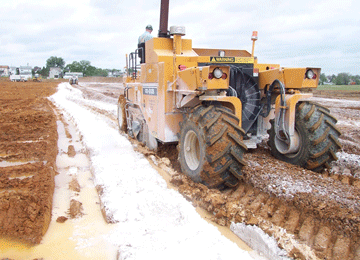Lime is a useful tool for earthwork contractors struggling with wet soils. When other drying methods have been exhausted (e.g. using an agricultural disc to turn the soil) and the schedule must be met, a common solution is to bring in lime.
Quicklime vs. Hydrated Lime
Although the term ‘lime’ is used loosely, it’s important to know that hardening or drying soils requires either quicklime or hydrated lime. More than one inexperienced contractor has assumed he could cut costs by running down to the local lawn and garden store and purchasing agricultural lime (calcitic or dolomitic lime) for this purpose. Since these types of lime don’t react to moisture in soil, the result is wet soils, wet agricultural lime, and a waste of money.
- Quicklime is manufactured by heating limestone (calcium carbonate) to approximately 900°C and grinding it into gravel, sand-sized particles, or a powder.
- Hydrated lime (calcium hydroxide) is produced by adding a controlled amount of water to quicklime, a process commonly referred to as “slaking.”
Because hydrated lime contains chemically-bonded water, approximately one-third more hydrated lime is typically required to dry the soil.
How Does the Process Work?
Chemically drying soils is accomplished by applying lime to wet soils to reduce the free (non-chemically bonded) water in the soil to achieve the optimal moisture content as determined by the soil’s moisture-density relationship. Approximately 1% to 2% of granular quicklime by dry weight of soil is normally applied, an amount not generally sufficient to achieve chemical modification or stabilization.
Strangely enough, the most common and costly mistake in lime application is inadequate moisture. When lime touches the moisture in the soil, a chemical reaction begins that causes heat, steam, and a rapid expansion of the lime to several hundred times its original volume. Sometimes additional water must be added to initiate the required chemical reaction. When too little water is available to completely hydrate the quicklime, water entering the soil after compaction causes expansive pressures to develop, resulting in the ground heaving; or even worse a pavement constructed on top. Proper incorporation of the lime into the soil is also necessary. It requires thorough mixing, and adequate time (approximately 24 to 48 hours) for the lime mixture to mellow (react with the soils). The final step requires remixing of the soil. Mixing and mellowing the soil should continue until there are no visible lime particles.
Using Lime for Small vs. Large Scale Projects
Typical small scale soil and mud drying applications are done using an agricultural disc, bulldozer or other equipment with a toothed bucket. For large projects, speciality contractors that use specialized lime spreading equipment are often utilized. For smaller areas, most chemical drying operations can be done with equipment already on hand. Lime products must also be used with care. Unreacted lime is a very strong alkaline chemical that can cause burns to the skin, as well as damage other surfaces it comes in contact with. The pH of lime is approximately 13, which is at the very upper end of the acid-base pH range. Dust control and proper use of personal protective equipment are critical. Contractors should review the material safety data sheet before beginning lime application.
Finally, lime isn’t a one-trick pony. Increasing the amount of lime mixed with the soil can also be used to modify expansive soils and stablize clayey soils. An appropriate mixture for these soil improvements should be determined by a qualified geotechnical engineer. The National Lime Association also has several publications available on their website that offers helpful guidance on using lime in construction.

